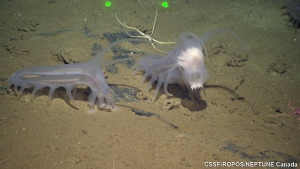The sea pig – Scotoplanes (Scotoplanes globosa)
Scotoplanes globosa, ~3000 m below surface in outer portion of Monterey Canyon off coast of central California (USA)
The sea pig is a genus of deep-sea holothurian echinoderm of the family Elpidiidae, order Elasipodida.
The 7,000 species of echinoderms that live in today’s oceans also include the starfish, sea urchins, brittle stars, and sea lilies. The 1,500 species of sea cucumbers, or holothurians, can be found in all oceans and at all depths, in a great variety of habitats – some burrow deep into mud or sand, while others may spend their entire lives swimming in midwater. It is in the dark reaches of the deep sea where the sea cucumbers rule. Here, a group known as the elasipods, of which Scotoplanes globosa is an example, can be found in enormous numbers (Dave Pawson, in litt. December 2009).
The bizarre deep-sea sea cucumbers were first described in wonderful detail by Swedish zoologist Hjalmar Théel in 1882, when he wrote a monograph of the astonishing collections amassed by the British research ship HMS Challenger in her round-the-world cruise of 1872-1876. Théel described about 65 new species which he placed in a new Order, the Elasipoda. The so-called elasipods are restricted to deep and cold parts of the world ocean, where they are the dominant large animals in most areas, often comprising more than 95% of the total weight of animals on the deep-sea floor. They are of great importance in the general economy of the deep sea, for as they feed on sediments, and move along on the seafloor, they introduce oxygen into the sediments, thus making them habitable by myriad small animals (Dave Pawson, in litt. December 2009).
Members of the Elpidiidae have particularly enlarged tube feet that have taken on a leg-like appearance, and are the only instance of legged locomotion amongst the holothurians, using water cavities within the skin (rather than within the leg itself) to inflate and deflate the appendages. These legs, in conjunction with their large, plump appearance (about 6 inches/15 cm long) have suggested the common name “sea pig”. There are other genera of Elpidiidae with a similar appearance that have also been referred to as “sea pigs”.
Scotoplanes live on deep ocean bottoms, specifically on the abyssal plain in the Atlantic, Pacific and Indian Ocean, typically at depths of over 1000 meters. Some related species can be found in the Antarctic. Scotoplanes (and all deep-sea holothurians) are deposit feeders, and obtain food by extracting organic particles from deep-sea mud. Scotoplanes globosa has been observed to demonstrate strong preferences for rich, organic food that has freshly fallen from the ocean’s surface, and uses olfaction to locate preferred food sources such as whale corpses.
Scotoplanes, like many sea cucumbers, often occur in huge densities, sometimes numbering in the hundreds when observed. Early collections have recorded 300 to 600 individual specimens per trawl. Sea pigs are also known to host different parasitic invertebrates, including gastropods (snails) and small tanaid crustaceans.
The main threat against Scotoplanes is deep-sea trawling. A single trawler sweep can catch and kill as many as 300 Scotoplanes. Since these animals make up a substantial part of the nutrition of deep-sea predators, this bycatch represents a serious threat to deep-sea life. A secondary threat to “scotoplanes” is the consumption of the creature in areas of Japan where they are considered a delicacy. The large, plump bodies have been associated with the taste of chicken.
http://echinoblog.blogspot.ca/
http://blogspotarchive.blogspot.com/2009/07/echinoblog.html.

